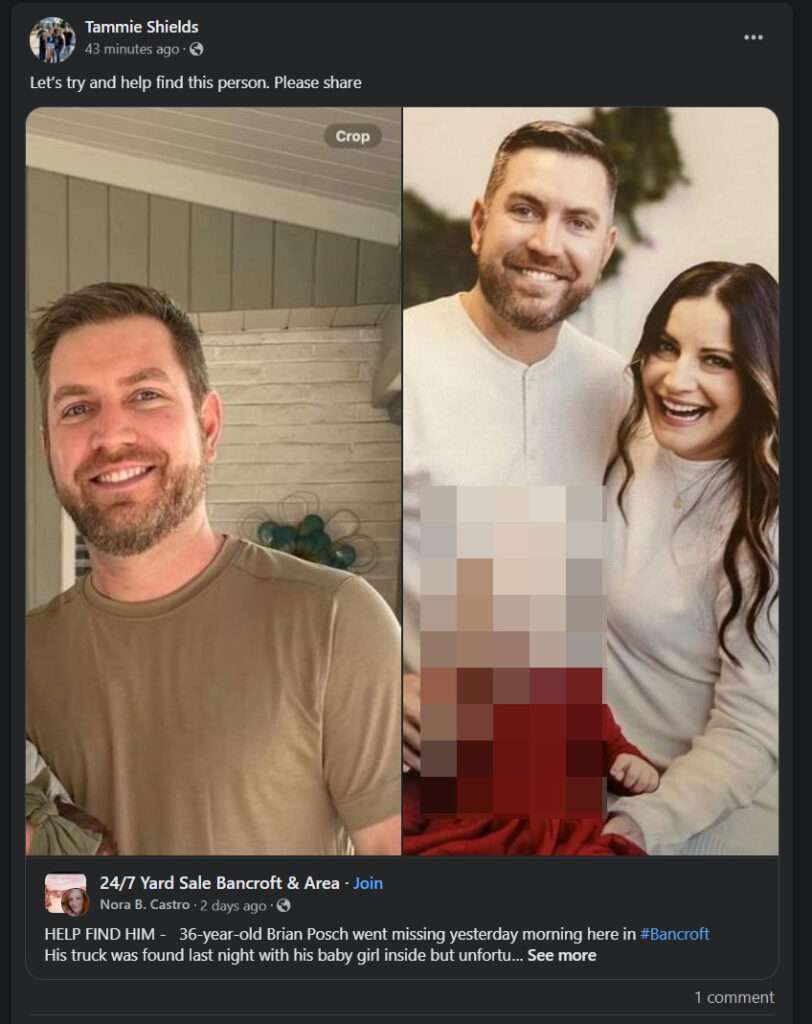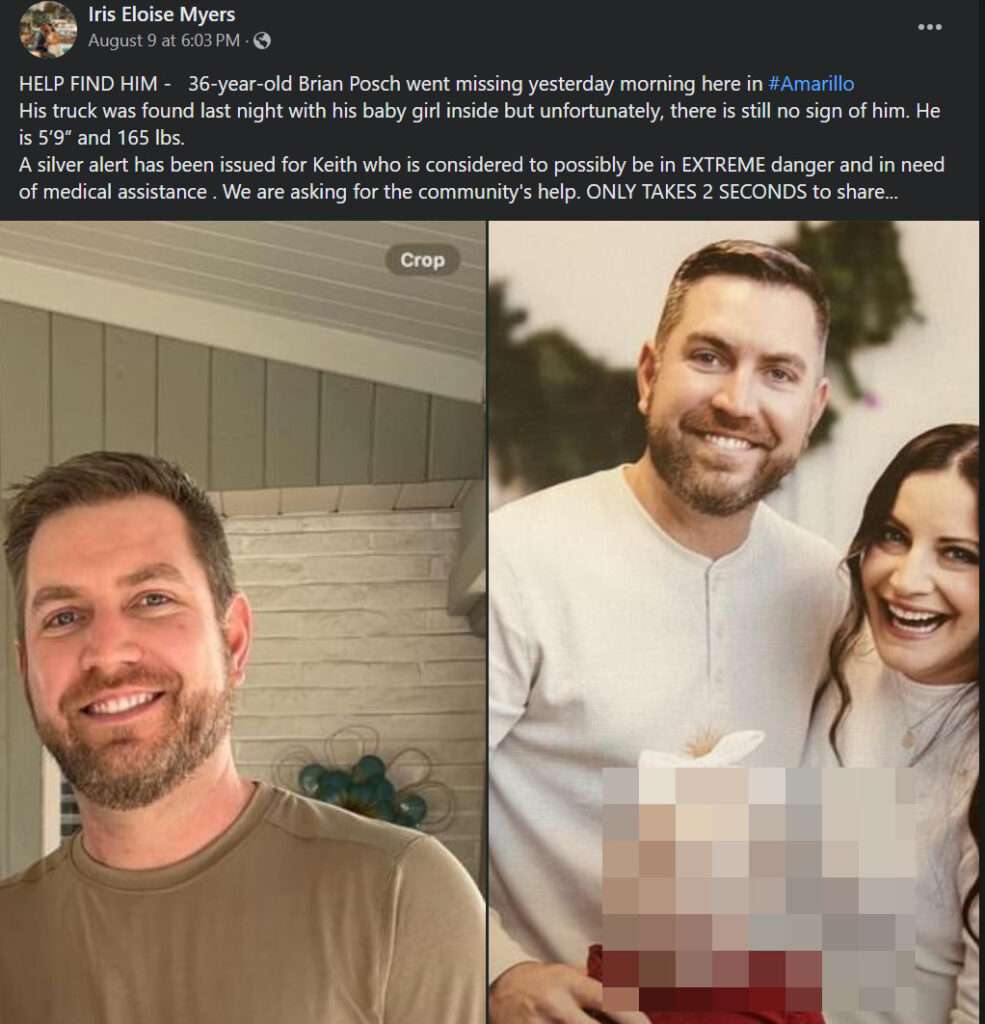Emotional posts begging for help finding 36-year-old Brian Posch have circulated Facebook in recent weeks. The posts claim Brian has been missing since “yestarday” after his truck was found with his baby girl inside. While the story tugs at heartstrings, it’s 100% fake. Let’s uncover the truth about this viral scam.

Recognizing This Viral Missing Person Scam
The Brian Posch missing person posts usually contain:
- An urgent call to “HELP FIND HIM”.
- Details like “36-year-old Brian Posch” and “He is 5’9″ and 165 lbs”.
- Mention of an endangered “silver alert” issued.
- A call to share saying “ONLY TAKES 2 SECONDS”.
This formula combines urgency, specifics, authority, and ease of helping. It’s carefully crafted for maximum emotion and shares.
The posts appear in local buy/sell groups like “Stuff For Sale”, making them seem targeted and legit. But it’s only to access specific audiences.

Detailed Overview of The Brian Posch Facebook Scam
The recurring Brian Posch missing person scam is a textbook example of how scammers manufacture false urgency on social media. By fabricating an emotional story and posting in local groups, they fool thousands into sharing and interacting.
Here are the key elements that enable this scam’s viral spread:
Crafting An Emotional Story
The scammers spent time perfecting heart-wrenching details:
- Brian is 36 with a baby girl, more reason to help.
- He suddenly went missing, urgency to act now.
- His truck was found with the baby alone, pulling at emotions.
- Mention of “EXTREME danger” and needing “medical assistance” creates worry.
This emotional core gets people invested in finding Brian before thinking logically.
Fabricating Authentic Details
Specifics like Brian’s age, height, weight, and the location date implant a sense of legitimacy. People trust detailed information.
Of course, these details are invented. But they prevent immediate skepticism.
Spreading in Targeted Local Groups
Posting in hyperlocal groups makes Brian seem like a real member of that community. People feel duty-bound to help someone “local”.
It also provides access to unaffected audiences ripe for manipulation.
Pressure to Share Immediately
Saying “takes 2 seconds to share” discourages critical thinking and scrutiny. It triggers a quick emotional reaction to share.
When shared within groups, friends and family see it and share too, perpetuating the scam’s spread.
Hook of a Missing Baby
The missing baby element generates immense emotional urgency. People imagine the baby in danger, compelling them to act now.
This distraction helps override logic like checking facts or news reports first.
Appearance of Authority
Mention of an official “silver alert” lends credibility to the story. People assume authorities vetted the information already.
In reality, no alert exists. But this detail discourages skepticism.
This potent blend of emotional manipulation, authentic-looking details, community relevance, urgency, and authority makes the scam extremely shareable. It takes advantage of humanitarian tendencies.
How Does The Brian Posch Missing Person Scam Actually Work?
While cleverly designed for virality, the scam has no intention of finding a missing person. Here are the steps:
1. Scammers Join Local Facebook Groups
The scammers target specific local audiences by joining relevant Facebook groups. This includes city pages, neighborhood groups, mothers’ groups, etc.
When people assume a local connection, they feel more inclined to share the post.
2. Crafted Story Sparks Immediate Concern
Once in the groups, the scammers post about Brian Posch missing. The details spark instant worry and urgency among group members.
People naturally want to help what they believe is a local father and baby in danger.
3. Rapid Sharing Spreads The Post
The empathetic call to action results in quick shares by group members. Friends and family of sharers then also see and share the post.
Within targeted groups, the viral spread begins as more people fall for the “urgent” story.
4. Increased Visibility Hooks More Victims
As rapid sharing grows, the scam posts start circulating wider on Facebook to those outside the groups.
Seeing how viral the posts are convinces more people Brian Posch must be real and urgently found.
5. Scammers Leverage Engagement For Profit
Now with a viral post, the scammers tap into the vast invested audience to make money.
They may edit posts to promote products, share affiliate links, harvest data, or sell the Facebook page. The engagement alone also looks valuable.
6. There Is Never Any Missing Person
Despite claims sharing will help find Brian Posch, he is not a real missing person. No one is ever found.
The scam just exploits empathy to fool thousands into spreading viral posts. Engagement is the only aim.
This emotional manipulation causes the scam’s rapid spread across Facebook groups and beyond. But some warning signs can help people identify the deceit.
Recognizing Warning Signs of The Scam
While these posts exploit humanitarian urges, some key signs can reveal their fraudulent nature:
- No credible news coverage – There are no legitimate news results for “Brian Posch missing”. Real silver alerts receive media attention.
- No details on the alert – The posts mention a “silver alert” but provide no specifics like who issued it or an alert number.
- No instructions beyond sharing – Legitimate missing appeals give clear direction on who to contact. These only say “shares help!”.
- Just a name and photo – There are no authenticating details like home city, family, workplace, etc.
- Posts in unrelated groups – Local sales groups have no reason to post a public missing person alert.
- Duplicate posts likely – If you see multiple instances of the same Brian Posch post, it’s certainly a scam attempting more reach.
- No call for evidence – Real missing alerts ask for any tips, possible sightings, or evidence from the public.
Staying alert for these warning signs is key. Think twice before reacting to any viral missing person appeals on Facebook. Verify first.
What To Do If You Shared The Brian Posch Post
If you already shared the scam Brian Posch missing person post, here are some smart steps:
- Delete your share immediately to stop aiding the scam’s reach.
- Comment on your original share to declare it a scam and warn contacts not to share further.
- Report the fraudulent post to Facebook for removal.
- Leave groups that distributed the scam post, as they lack proper moderation.
- Be wary of more viral posts from groups you are still in.
- Advise your friends to exercise skepticism before sharing emotional viral content.
Though your intentions were good, deleting your post and warning others stops the scam’s spread. Do your part to prevent the scammers from exploiting more people.
Avoiding Future Missing Person Scams
Here are some practices to stay vigilant against posts like the fake Brian Posch story:
- Pause before sharing – Give yourself time to verify facts, no matter how urgent it seems. Don’t instantly react.
- Search for news reports – Legitimate missing cases will be covered by local media and police. Scams exist in isolation on Facebook.
- Verify details – Search the person’s name, location, officials involved, etc. Fakes don’t withstand scrutiny.
- Check group relevance – Question why unrelated groups like local sales pages would post a public missing alert.
- Look for duplicates – Scammers reuse posts across groups. Multiple instances indicate a scam.
- Contact original poster – Message the poster for more info. No response or vagueness likely means a scam.
- Trust official sources – Get missing child info from resources like the National Center for Missing and Exploited Children.
- Report suspicious posts – Use Facebook’s tools to report any posts that seem deceitful. This helps suppress scams.
Staying vigilant helps curb the impact of false viral content. We all want to help missing people, but verifying before sharing is critical.
Frequently Asked Questions About The Brian Posch Missing Person Scam
1. Who is Brian Posch?
Brian Posch is a fictional persona made up by scammers to create fake missing person posts. He is not a real missing person. The posts use his fake name and photo to make the scam appear legitimate and emotional.
2. What do the Brian Posch missing posts say?
The posts describe 36-year-old Brian Posch suddenly going missing. They include details like his age, height, weight, and baby daughter also missing to create urgency. The posts implore readers to share to help “find” Brian.
3. Where do these posts appear?
The scam posts appear in local Facebook groups like city pages, neighborhood groups, mothers’ groups, selling groups, etc. This targets specific local audiences who feel more inclined to share missing person posts from their area.
4. What is the purpose of this scam?
The sole purpose is to generate shares, reactions, and comments by exploiting humanitarian tendencies. There is no actual missing person. The engagement helps scammers profit later.
5. How can I recognize these posts as a scam?
Warning signs include no news reports, vague details, unrelated posting groups, pressure to share instead of guidance, duplicated posts, and zero call for evidence from the public.
6. What should I do if I shared one of these posts?
Delete your share immediately so you stop aiding the scam. Comment that it is fake. Report the post to Facebook. Leave groups that allow such scams.
7. How can I avoid falling for similar scams?
Always verify details, search for news reports, check group relevance, contact the poster, look for duplicates, and rely on official missing children resources before sharing.
8. How can I help stop these scams?
Report suspicious posts. Share facts on your page after research. Advise friends to exercise skepticism before sharing emotional viral content.
9. Where can I learn more about missing persons scams?
Refer to trustworthy sources like the National Center for Missing and Exploited Children. Avoid solely relying on unverified viral posts that may be scams.
10. Who can I contact about a real missing persons case?
If you have information on a legitimate missing person, contact the law enforcement agency handling the case or the National Center for Missing and Exploited Children immediately.
The Bottom Line
The recurring Brian Posch missing person scam reveals how easy it is to manufacture false urgency on social media using emotional hooks and local posting.
It exploits humanitarian tendencies by crafting an authentic-looking but 100% fake story. The sole goal is engagement and profits, not finding a missing person.
When you see:
- Viral missing person posts
- Emotional hooks like missing children
- Detailed stories aimed at authenticity
- Pressure to share instead of guidance for real help
- Appearance of authority via alerts
- Targeting of local community groups
Slow down and investigate thoroughly. It will become clear these are not real missing people, just fabricated stories to exploit well-meaning users.
By recognizing these manipulative tactics, we can stop scammers from profiting off deception. Don’t let fake posts take advantage of your inclination to help others.
Here are some final tips:
- Verify before sharing any viral missing person appeals. Scrutinize details.
- Report duplicates and suspicious posts using Facebook’s tools. This disrupts scams.
- Delete your share if you posted the scam, and warn your friends who also shared. Stop its spread.
- Advise friends and family to exercise skepticism before sharing emotional viral posts.
- Leave groups that distributed viral scam posts, as they lack proper moderation.
- Get missing children alerts directly from authoritative sources like the National Center for Missing and Exploited Children.
By working together and staying vigilant, we can contain the impact of misleading viral campaigns that try to exploit empathy and urgency. Don’t let scammers manipulate your compassion. Verify first, share facts, and urge your community to think critically.










